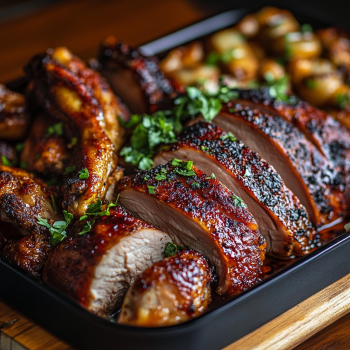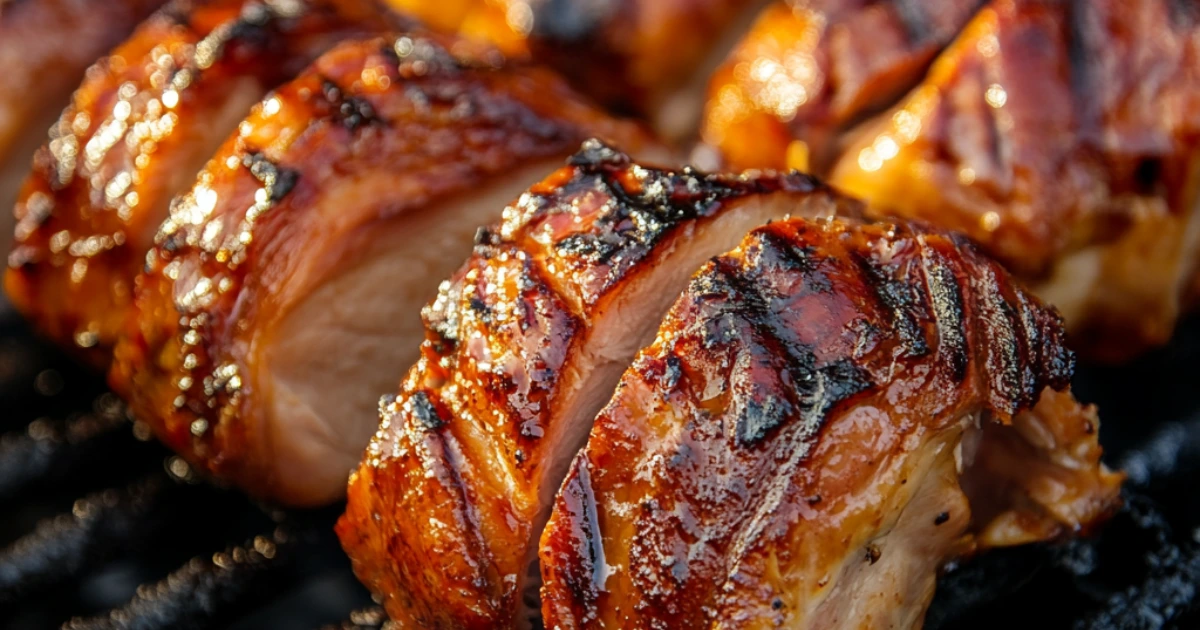Introduction
Smoked turkey tails are a flavorful and often overlooked delicacy that can elevate a wide range of dishes. Known for their rich, smoky taste and tender texture, they have become a staple in Southern and island cuisines and are gaining recognition in kitchens worldwide. Whether slow-cooked in stews, roasted for a crispy finish, or used to enrich broths and sauces, it bring a depth of flavor that’s hard to replicate.
This guide will explore everything you need to know about turkey tails, from their preparation and nutritional benefits to popular recipes and cooking techniques. If you’re looking to incorporate a versatile and delicious ingredient into your meals, smoked turkey tails might just become your new favorite addition.
Table of Contents
What Are Smoked Turkey Tails?
Smoked turkey tails are the fatty, flavorful appendage at the base of a turkey’s spine, cherished for their rich taste and tender texture. Known for their high-fat content, they are celebrated for their ability to infuse dishes with a smoky, savory essence. Typically, they are smoked over wood chips to achieve their distinctive flavor.
Key Characteristics:
- High in natural fat, which makes them tender and deeply flavorful.
- Traditionally used in soups, stews, and slow-cooked dishes to enhance taste and richness.
- Versatile in a range of cuisines, lending themselves to both traditional and creative recipes.
Smoked turkey tails are a beloved ingredient in Southern and Pacific Island cooking, often featured in comfort foods that provide warmth, satisfaction, and a taste of home.celebrate their rich flavor.
Nutritional Profile
While smoked turkey tails are known for their indulgent taste, they also offer several nutritional benefits when consumed in moderation. They are rich in essential fats and proteins, providing energy and supporting muscle health.
Nutritional highlights:
- High in protein: Supports muscle repair and growth.
- Rich in fats: Provides energy but should be consumed mindfully due to high caloric content.
- Contains minerals: Includes phosphorus and iron, which support bone health and red blood cell production.
However, their high fat and sodium levels (from the smoking process) mean they should be eaten as part of a balanced diet.
How Smoked ?
The preparation of smoked turkey tails involves a mix of seasoning, curing, and smoking. This process locks in moisture and infuses the tails with smoky, savory flavors.
Steps in preparation:
- Seasoning: Turkey tails are rubbed with a mix of salt, spices, and sometimes sugar.
- Curing: They are often cured to enhance flavor and extend shelf life.
- Smoking: Using wood chips like hickory or applewood, the tails are slow-smoked until tender.
The process transforms turkey tails into a flavorful delicacy that’s ready to elevate a variety of dishes.
Traditional Dishes Featuring
Smoked turkey tails hold a special place in many traditional cuisines. Their smoky flavor and rich texture make them a staple in comfort food recipes.
Popular Traditional Uses:

- Collard Greens: A Southern classic where turkey tails add a deep, savory flavor to this hearty vegetable dish.
- Stews and Soups: They enhance broths with their smoky, savory taste, making the dishes more satisfying and flavorful.
- Island-Style Dishes: In Pacific Island cuisine, smoked turkey tails are often paired with root vegetables or rice, creating comforting and filling meals.
These dishes highlight the versatility and cultural significance of smoked turkey tails, showcasing their ability to elevate simple ingredients into rich and flavorful creations.the cultural significance and versatility of turkey tails in traditional cooking.
Cooking with Smoked Turkey Tails
Cooking smoked turkey tails is straightforward, but understanding their unique properties can help you maximize their flavor. Their high-fat content means they pair well with bold spices and slow-cooking techniques.
Cooking methods:
- Simmering: Perfect for soups and stews.
- Roasting: Enhances the smoky flavor with a crispy texture.
- Slow cooking: Breaks down the fat for a melt-in-your-mouth experience.
How to Cook Smoked Turkey Tails
No matter the method, smoked turkey tails add a delicious and distinct flavor to any dish.
Popular Recipes Featuring Smoked Turkey Tails
Smoked turkey tails are a delicious addition to a wide range of recipes, from traditional favorites to innovative modern dishes.
Recipe Ideas:
- Turkey Tail Soup: A hearty and comforting soup made with fresh vegetables and a rich, smoky broth.
- Collard Greens: A Southern classic, perfect for family gatherings, with turkey tails adding incredible depth and flavor.
- Turkey Tail Fried Rice: A creative fusion dish that blends the smoky richness of turkey tails with savory, flavorful rice.
Experimenting with these recipes allows you to fully explore the incredible versatility of turkey tails, transforming them into delightful, satisfying meals for any occasion.satisfying and memorable meals.
Health Benefits of Smoked Turkey Tails
While indulgent, it can offer health benefits when consumed in moderation. They provide a good source of protein and essential fats.

Benefits:
- Protein-rich: Supports muscle growth and repair.
- Source of minerals: Includes iron and phosphorus for overall health.
- Energy-dense: Useful for active individuals needing calorie-dense meals.
By pairing with vegetables and whole grains, you can create a balanced meal that’s both delicious and nutritious.
Comparing Smoked Turkey Tails to Other Smoked Meats
Smoked turkey tails offer unique qualities that set them apart from other smoked meats. Unlike smoked sausage , are higher in fat and have a softer, more tender texture.
Comparison highlights:
- Higher fat content: Gives turkey tails a richer flavor.
- Distinct smoky aroma: Pairs well with bold spices and hearty dishes.
- Versatility: Ideal for soups, stews, and roasting.
While smoked turkey tails are indulgent, they offer a unique flavor profile that makes them a standout ingredient.
Common Mistakes When Cooking Smoked Turkey Tails
Avoiding common mistakes can help you achieve the best results when preparing smoked turkey tails.
Mistakes to avoid:
- Overcooking: Leads to overly dry or tough meat.
- Underseasoning: Fails to balance the smoky flavor.
- Skipping proper preparation: Neglecting to trim excess fat can make the dish too greasy.
By cooking with care and attention to detail, you can enjoy perfectly tender and flavorful turkey tails.
Where to Buy Smoked Turkey Tails
Smoked turkey tails can be found at specialty grocery stores, butcher shops, and online retailers. When shopping, look for high-quality products with minimal additives.
Shopping tips:
- Visit local markets: Often offer fresh, naturally smoked turkey tails.
- Check online retailers: Provide a wide selection, including organic options.
- Look for quality labeling: Ensure humane and sustainable sourcing.
Knowing where to buy smoked turkey tails ensures you get the best flavor and quality.
Storing and Reheating
Proper storage and reheating are essential to preserve the flavor and texture of turkey tails.
Tips:
- Refrigerate leftovers: Store them in an airtight container and keep them in the refrigerator for up to 4 days.
- Freeze for long-term storage: Use freezer-safe bags or containers to store turkey tails in the freezer for up to 3 months.
- Reheat gently: Warm the turkey tails on low heat to retain their moisture and prevent them from drying out.
By following these practices, you can enjoy turkey tails at their best, even as delicious leftovers!
Are Smoked Turkey Tails Healthy?
can be part of a healthy diet when consumed in moderation. Their high-fat content provides energy, while their protein and minerals offer nutritional benefits.
Key points:
- Rich in protein: Supports muscle health.
- High in fat: Provides energy but should be balanced with other foods.
- Moderate sodium: Check labels to avoid overly salty options.
Pairing them with nutrient-dense sides like vegetables ensures a balanced and satisfying meal.
The Ultimate Guide to Preparation, Smoking, and Serving Turkey Breasts
Ethical and Sustainable Practices
Choosing ethically and sustainably sourced it is important for supporting responsible farming practices. Look for products labeled as organic or certified humane.
Tips:
- Support local farms: Prioritize community-based producers.
- Choose sustainably smoked options: Opt for natural wood-smoking methods.
- Minimize food waste: Incorporate turkey tails into diverse recipes.
By making mindful choices, you contribute to a more sustainable food system.
FAQs:
good to eat?
Yes, are delicious and packed with rich, smoky flavor. Their high-fat content makes them tender and flavorful, which is why they are often used in slow-cooked dishes, soups, and stews. However, due to their fat and sodium levels, they should be consumed in moderation as part of a balanced diet.
How long does it take for smoked turkey tails to get done?
The cooking time varies depending on the method used. For instance, when simmering or slow cooking, it typically takes about 1 to 1.5 hours for the meat to become tender. On the other hand, if you are roasting, you should allow approximately 45 minutes to 1 hour at 350°F. Moreover, it is essential to always check that the internal temperature reaches 165°F to ensure safety. In summary, adjusting the cooking time according to the method and verifying the temperature are crucial for perfect results..
What part of the turkey is smoked turkey tails?
The turkey tail is a small, fatty piece of meat located at the base of the turkey’s back, where the tail feathers attach. It is rich in fat and connective tissue, which makes it tender and flavorful when smoked.
What do you do with the turkey tail?
Turkey tails are incredibly versatile in the kitchen, offering countless ways to elevate your meals. For example, they can be slow-cooked in stews or soups, adding a rich, smoky flavor to the dish. They can also be roasted to achieve a crispy texture and savory taste, making them a delightful addition to any side dish. Additionally, turkey tails serve as an excellent flavor base for dishes like collard greens or hearty gravies. They can also be simmered in broth to enrich the flavor of stocks and sauces. Overall, their adaptability makes them a fantastic ingredient for creating delicious and satisfying recipes.
What are the cons of turkey tail?
While turkey tails are flavorful, they do have some drawbacks:
- High in fat: The rich fat content can make them calorie-dense.
- High in sodium: Smoked versions often contain added salt, which may not suit those on low-sodium diets.
- Moderate nutritional value: While they provide protein and energy, they lack significant amounts of vitamins and fiber.
Balancing turkey tails with nutrient-dense foods can mitigate these concerns.
Why don’t we eat turkey tails?
Turkey tails are less commonly eaten in some cultures due to their high fat content and association with being a byproduct of the turkey. Historically, they were discarded or used for stock, but they have gained popularity in many cuisines for their rich flavor.
Is turkey tail hard on the liver?
Excessive consumption of fatty foods, including turkey tails, may place strain on the liver, especially if consumed frequently or in large quantities. Moderation is key to ensuring that their fat content does not negatively impact liver health, particularly for individuals with pre-existing conditions.
What culture eats turkey tails?
Turkey tails are popular in several cultures around the world:
- Pacific Islands: Particularly in Samoa and Tonga, where they are a traditional delicacy.
- Southern United States: Often used in soul food recipes, like collard greens and stews.
- Caribbean cuisines: Frequently incorporated into hearty soups and rice dishes.
These cultures value turkey tails for their flavor and versatility in cooking.
Does tail affect blood pressure?
Smoked turkey tails may contribute to elevated blood pressure due to their high sodium content from the curing and smoking process. Individuals with hypertension or those monitoring their sodium intake should consume them sparingly and balance them with low-sodium ingredients like fresh vegetables.
Conclusion
Smoked turkey tails are a flavorful and versatile ingredient that can elevate a variety of dishes. From their rich nutritional profile to their cultural significance, they offer more than just great taste. By understanding their preparation, cooking methods, and health benefits, you can make it a regular feature in your kitchen. Whether you’re simmering them in soups, roasting them to perfection, or exploring traditional recipes, are a delicacy worth savoring.


4 thoughts on “Smoked Turkey Tails”